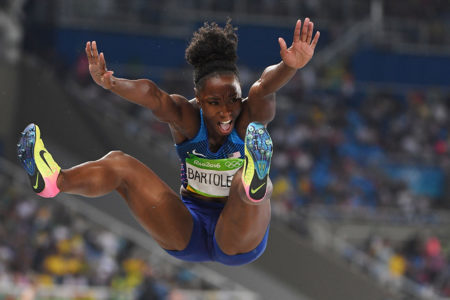 October is usually an ultra-slow month in the track & field world, but in the middle of this year’s tenth month, suddenly there were probably more track-related stories in the media than any other month this year. The reason was simple: the 50th anniversary of the Mexico City Olympics rolled around, and there were no end of fascinating plotlines to be revisited, both on the track and off. We decided that the best way to cover so many angles was simply to transport all you readers back to that moment in time. For some of you, it’ll be just a memory from the ancient past; for others, it’ll be something you revisit regularly; and for yet others, it’ll be fertile new ground to be tilled. Whatever it is to you, we’re happy to be able to reproduce for subscribers, in searchable-PDF fashion, the October/November 1968 edition of T&FN. (If you’re not a subscriber, here’s a sneak-peek.)
October is usually an ultra-slow month in the track & field world, but in the middle of this year’s tenth month, suddenly there were probably more track-related stories in the media than any other month this year. The reason was simple: the 50th anniversary of the Mexico City Olympics rolled around, and there were no end of fascinating plotlines to be revisited, both on the track and off. We decided that the best way to cover so many angles was simply to transport all you readers back to that moment in time. For some of you, it’ll be just a memory from the ancient past; for others, it’ll be something you revisit regularly; and for yet others, it’ll be fertile new ground to be tilled. Whatever it is to you, we’re happy to be able to reproduce for subscribers, in searchable-PDF fashion, the October/November 1968 edition of T&FN. (If you’re not a subscriber, here’s a sneak-peek.)
I was a college senior with a huge statistical bent when Mexico City unfolded. To say that I was blown away on a daily basis would be to understate the bug-eyed nature of my existence for the week-plus it took for all the track & field action to play out. I didn’t care that it took a while to fill in all the cracks. As you’ll note in his diary-of-a-stay-at-home column on p. 59 of that issue, Editor Bert Nelson was far less forgiving in his column on things he’d remember:
“ABC-TV directors, who earned the enmity of every true track fan by treating the Games not as a news event but as a sports spectacular. Great action was weakened by the dearth of news and not until the next morning was it possible to know more than a small portion of what happened. ABC-TV announcers, who usually commented on performances without giving results, performances or lap times.” Hmmm, are we sure he didn’t write that just yesterday?
But overall, Bert was unstinting in his praise, saying, “It was, everybody says, a fantastic track meet. I readily agree. Just how great it was is hard to describe, as greatness is a relative thing. But I have one unique indication that it was twice as good as anything that has gone before.” This from a man who had had a brief childhood experience at LA ’32 before going to London ’48, Helsinki ’52, Melbourne ’56, Rome ’60 & Tokyo ’64.
In his story on the triple jump, Managing Editor Dick Drake’s telling line of that event applied to many disciplines: “The overall achievements will boggle the minds of statisticians for uncounted Olympiads ahead.”
He was right, and that’s where the dichotomy part of the story creeps in. As I said, my predilection was (and still is) towards the statistical side of the sport, and after being hired as T&FN’s Statistician the next year I began to realize that the Mexico City numbers were throwing stats out of whack in events benefited by the thin air. And that realization only grew through the years, to the point where I’ve been known to say that Mexico City was one of the worst things that ever happened to the sport.
I love to preach the gospel that track should be all about head-to-head competition, but let’s face it, it’s a sport that is records-driven. And breaking WRs in many high-profile events suddenly became very hard to do. I’m not saying that Jim Hines, Tommie Smith (my favorite athlete at that time), Lee Evans & Bob Beamon, just to name a high-profile few, wouldn’t have set World Records at a low-altitude Olympics. I firmly believe they would have—that’s how the sport worked in those days when it was almost expected that a gold medal be accompanied by a WR. But I also believe that those records would have been quickly supplanted by others. The normal cycle was interrupted.
It’s not that my predecessors at the magazine didn’t realize that the thin air was “helpful”; they just didn’t realize how helpful. They were more concerned with thinking about how the oxygen-poor altitude was slowing down the distance runners, with the prevailing attitude perhaps best expressed by disappointed WR holder Ron Clarke, who said, “It was an Olympics for the men of the mountains. Maybe we were naïve to think we could run with them here. There are a lot of us who’d like to race the Kenyans somewhere else.” It didn’t take all that many years, of course, before the Kenyans proved they could beat anybody, anywhere, anytime.
Perhaps the most disconcerting thing about the Mexico City results was the wind readings in the jumps, and that went largely unexplored at the time. There were 5 WRs set in the men’s TJ, and the wind readings on those five jumps were (in order of the setting) 0.0, 0.0, 2.0, 2.0, 2.0. Sure, sounds logical to me. Both long jump WRs fell: Beamon’s reading was 2.0, Viorica Viscopoleanu’s was 0.0. (Historical note: Igor Ter-Ovanesyan set a LJ record in Mexico City in ’67 and João Oliveira a TJ mark in ’75: the reading on each was… 2.0.)
But all in all, man do I wish I had been there. So it might have meant skipping a semester—isn’t any Olympics worth that? □






